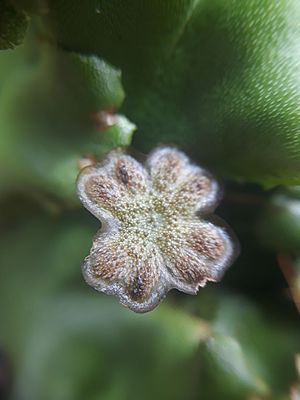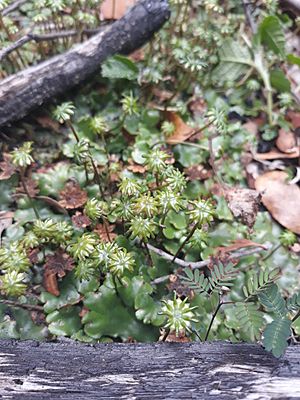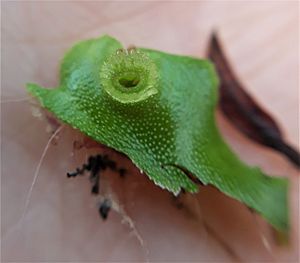Marchantia berteroana facts for kids
Quick facts for kids Marchantia berteroana |
|
|---|---|
| Scientific classification | |
| Kingdom: | |
| Division: | |
| Class: |
Marchantiopsida
|
| Order: |
Marchantiales
|
| Family: |
Marchantiaceae
|
| Genus: |
Marchantia
|
| Species: |
M. berteroana
|
| Binomial name | |
| Marchantia berteroana Lehm. and Lindenb.
|
|
Marchantia berteroana is a type of plant called a liverwort. It belongs to the Marchantia group. Liverworts are small, simple plants that don't have true roots, stems, or leaves like most plants you know.
Contents
What Does Marchantia berteroana Look Like?
Marchantia berteroana is a flat, green plant that spreads out like a mat. This flat part is called a thallus. It can grow up to 2 centimeters (about 0.8 inches) long and 1.2 centimeters (about 0.5 inches) wide.
The thallus can be dark green or yellow and often looks shiny. It sticks to the ground using tiny root-like structures called rhizoids. If you look very closely with a magnifying glass, you might see tiny holes, called pores, on its top surface.
How Marchantia berteroana Reproduces
Marchantia berteroana has special parts for reproduction, just like flowers on other plants. These parts are called gametangia. Each plant is either male or female.
- Male parts are called antheridiophores. They are short and have a flat, disc-like top, about 1 centimeter wide.
- Female parts are called archegoniophores. They have a taller stem with an umbrella-like top, also about 1 centimeter wide. This umbrella shape is why some people call them "umbrella liverworts."
Besides sexual reproduction, Marchantia berteroana can also make copies of itself without needing male and female parts. It does this using small cups on its surface called gemma cups. These cups are about 4 millimeters wide and 3 millimeters high.
Inside the gemma cups are tiny plant pieces called gemmules. When raindrops fall into the cups, they splash the gemmules out. These gemmules can then grow into new Marchantia berteroana plants. Gemma cups are more common in winter when there's more rain.
How to Tell Marchantia berteroana Apart from Similar Plants
There are other liverworts that look a lot like Marchantia berteroana. One common one is Marchantia polymorpha.
Here's how to spot the differences:
- M. polymorpha is usually a duller green and often has a dark line down the middle of its top surface.
- M. berteroana is a brighter green and usually doesn't have any dark lines.
Also, if you look at the underside of M. berteroana, you'll see clear, see-through scales. This helps tell it apart from Marchantia foliacea, which has dark purple or brown scales underneath.
Where Does Marchantia berteroana Live?
Distribution Around the World
Marchantia berteroana can be found in many places across the Southern Hemisphere. It lives in:
- Australia
- New Zealand
- Southern Africa
- South America
- Antarctica
It also grows on islands like Papua New Guinea, Java, New Caledonia, and other smaller islands.
What Kind of Habitat Does it Prefer?
This liverwort loves places that are wet and moist. You can often find it:
- Near fresh water, like streams or rivers.
- In areas where waterfalls splash.
- On the floors of forests.
Interestingly, M. berteroana is one of the first plants to grow back in Tasmanian forests after a bushfire. It helps new life start in burned areas.




